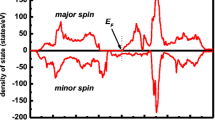Abstract
Using an effective low-energy Hamiltonian derived from the first-principles electronic structure calculations for the narrow t 2g bands of YTiO3, LaTiO3, YVO3, and LaVO3, we evaluate the contributions of the correlation energy E c to the stability of different magnetic structures that can be realized in these distorted perovskite oxides. We consider two approximations for E c that are based on regular perturbation theory expansion around a nondegenerate Hartree-Fock ground state. One is the second order of perturbation theory, which allows comparing the effects of local and nonlocal correlations. The other is the local t-matrix approach, which allows treating some higher-order contributions to E c . The correlation effects systematically improve the agreement with the experimental data and additionally stabilize the experimentally observed G- and C-type antifer-romagnetic (AFM) structures in YVO3 and LaVO3, although the absolute magnitude of the stabilization energy is sensitive to the level of approximations and is somewhat smaller in the t-matrix method. The nonlocal correlations additionally stabilize the ferromagnetic ground state in YTiO3 and the C-type AFM ground state in LaVO3. Among two inequivalent transition-metal sites in the monoclinic structure, the local correlations are stronger at the sites with the least distorted environment. Limitations of the regular perturbation-theory expansion for LaTiO3 are also discussed.
Similar content being viewed by others
References
D. A. Maclean, H.-N. Ng, and J. E. Greedan, J. Solid State Chem. 30, 35 (1979); M. Itoh, M. Tsuchiya, H. Tanaka, and K. Motoya, J. Phys. Soc. Jpn. 68, 2783 (1999); J. Akimitsu, H. Ichikawa, N. Eguchi, et al., J. Phys. Soc. Jpn. 70, 3475 (2001); C. Ulrich, G. Khaliullin, M. Reehuis, et al., Phys. Rev. Lett. 89, 167202 (2002); F. Iga, M. Tsubota, M. Sawada, et al., Phys. Rev. Lett. 93, 257207 (2004).
B. Keimer, D. Casa, A. Ivanov, et al., Phys. Rev. Lett. 85, 3946 (2000); M. Cwik, T. Lorenz, J. Baier, et al., Phys. Rev. B 68, 060401(R) (2003).
Y. Ren, T. T. M. Palstra, D. I. Khomskii, et al., Nature 396, 441 (1998); G. R. Blake, T. T. Palstra, Y. Ren, et al., Phys. Rev. B 65, 174112 (2002); A. A. Tsvetkov, F. P. Mena, P. H. M. van Loosdrecht, et al., Phys. Rev. B 69, 075110 (2004); C. Ulrich, G. Khaliullin, J. Sirker, et al., Phys. Rev. Lett. 91, 257202 (2003).
V. G. Zubkov, G. V. Bazuev, V. A. Perelyaev, and G. P. Shveikin, Sov. Phys. Solid State 15, 1079 (1973); P. Bordet, C. Chaillout, M. Marezio, et al., J. Solid State Chem. 106, 235 (1993).
H. Sawada and K. Terakura, Phys. Rev. B 58, 6831 (1998); Z. Fang and N. Nagaosa, Phys. Rev. Lett. 93, 176404 (2004).
M. Mochizuki and M. Imada, Phys. Rev. Lett. 91, 167203 (2003); R. Schmitz, O. Entin-Wohlman, A. Aharony, et al., Phys. Rev. B 71, 144412 (2005).
G. Khaliullin and S. Maekawa, Phys. Rev. Lett. 85, 3950 (2000).
G. Khaliullin and S. Okamoto, Phys. Rev. Lett. 89, 167 201 (2002); P. Horsch, G. Khaliullin, and A. M. Oleś, Phys. Rev. Lett. 91, 257203 (2003).
Y. Imai, I. Solovyev, and M. Imada, Phys. Rev. Lett. 95, 176 405 (2005).
I. V. Solovyev, Phys. Rev. B 73, 155117 (2006).
I. V. Solovyev, Phys. Rev. B 74, 054412 (2006).
I. V. Solovyev, Phys. Rev. B 69, 134403 (2004).
J. Friedel and C. M. Sayers, J. Phys. (Paris) 38, 697 (1977); F. Kajzar and J. Friedel, J. Phys. (Paris) 39, 397 (1978); G. Treglia, F. Ducastelle, and D. Spanjaard, J. Phys. (Paris) 41, 281 (1980).
K. A. Brueckner and C. A. Levinson, Phys. Rev. 97, 1344 (1955).
V. Galitskiĭ, Zh. Éksp. Teor. Fiz. 34, 151 (1958) [Sov. Phys. JETP 7, 104 (1958)].
J. Kanamori, Prog. Theor. Phys. 30, 275 (1963).
I. V. Solovyev, Z. V. Pchelkina, and V. I. Anisimov, Phys. Rev. B 75, 045110 (2007).
O. K. Andersen, Phys. Rev. B 12, 3060 (1975); O. K. Andersen, Z. Pawlowska, and O. Jepsen, Phys. Rev. 34, 5253 (1986).
A. Georges, G. Kotliar, W. Krauth, and M. J. Rozenberg, Rev. Mod. Phys. 68, 13 (1996).
Y. Otsuka and M. Imada, J. Phys. Soc. Jpn. 75, 124707 (2006).
Author information
Authors and Affiliations
Additional information
The text was submitted by the authors in English.




